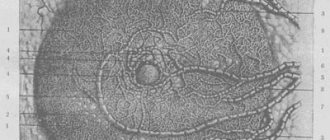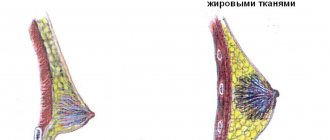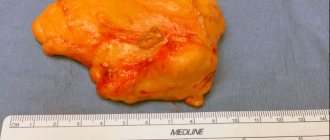Breast cancer in men is a malignant neoplasm that grows from the cells of the rudimentary mammary glands. In most cases, breast cancer in men is diagnosed against the background of hyperestrogenemia (excessive increase in estrogen in the blood) and enlargement of the mammary glands. As the tumor grows, regional lymph nodes enlarge, and pain occurs associated with the spread of the oncological process to the surrounding tissues, namely the chest. At the last stage, when cancer cells begin to metastasize, dysfunction of target organs is observed.
Effective treatment of breast tumors in men requires timely and high-quality diagnostics, which any patient can receive within the walls of the Yusupov Hospital Oncology Center. Leading world-renowned clinic specialists will conduct a full clinical and laboratory examination and select the correct therapy for various oncological diseases. The treatment program also includes rehabilitation measures for recovery after surgery and radiation therapy.
Some statistics
Breast cancer in men is a fairly rare disease. According to the American Cancer Society, less than 1% of all breast cancer patients are representatives of the stronger sex. That is, in women such a tumor occurs 100 times more often.
At the same time, the disease is diagnosed much less frequently in men in the early stages. Experts attribute this to the fact that men more often ignore a lump in the chest and, as a rule, consult a doctor at higher stages of the pathology. Therefore, the mortality rate from breast cancer among men is 25% higher than among women. In addition, men with this diagnosis have an increased risk of developing melanoma, as well as tumors of the second breast and prostate.
Cost of breast surgery
All measures related to the preliminary examination are included in the cost of correction of the nipple-areolar complex. If contraindications are identified that prevent plastic surgery, the patient pays only the cost of the examination. If there are no restrictions for the operation, then payment is made for the entire range of medical services performed, which may include subsequent rehabilitation with personal supervision by a plastic surgeon during the recovery process.
What is the price for nipple correction in Moscow? The cost of nipple-areolar complex plastic surgery depends on the type of surgery that the plastic surgeon will perform. Correction of a long nipple costs about 40-60 thousand rubles. The price of surgery for areola reduction starts at 15 thousand rubles. Complex surgical correction of nipples and areolas at the Maxim Osin plastic surgery clinic on an all-inclusive basis will cost patients 100 thousand rubles.
Risk factors
Causes of breast cancer in men may include:
- smoking;
- age over 60 years;
- eating disorders;
- cases of malignant breast tumors in relatives, both men and women;
- presence of a mutant BRCA2 gene;
- liver cirrhosis, Klinefelter syndrome and other diseases that are associated with the development of an imbalance of sex hormones: an increase in the concentration of female estrogen or a decrease in the concentration of male testosterone;
- excess body weight, because adipose tissue produces a lot of estrogen-like substances that can provoke the appearance of tumors;
- true gynecomastia - development of the mammary gland according to the female type with active growth of glandular rather than adipose tissue;
- taking medications containing estrogens;
- exposure to ionizing radiation;
- alcohol abuse.
Contraindications to plastic surgery
If, after correction of the nipples or areolas, you plan to give birth to a child and breastfeed him, then plastic surgery should be postponed. Because all the efforts of the surgeon and the money spent on plastic surgery will be nullified - breastfeeding a child is one of the key factors determining significant changes in the shape and size of the nipple-areolar complex.
In addition to reasons related to breastfeeding, a number of medical contraindications are a limitation for plastic surgery. These include the following chronic and general diseases:
- diabetes;
- hypertension;
- cardiovascular failure;
- oncological pathologies;
- problems with hematopoiesis.
Contraindications for correction are clarified during a medical consultation and subsequent medical examination with all necessary tests.
What type of malignant breast tumors is most common in men?
The most common type of pathology in the stronger sex - infiltrating ductal cancer - originates from the epithelium of the milk ducts. In addition, breast cancer in men is often combined with an active inflammatory process. In this case, the so-called inflammatory carcinoma develops - a large tumor that quickly spreads to nearby tissues. Also in men, tumor lesions of the nipple occur, which becomes a malignant complication of Paget's disease.
But lobular or lobular carcinoma, which originates from the gland tissue, and not from the ducts, is very rarely diagnosed in men. The reason is that normally there is very little such tissue in the male mammary gland. Its quantity increases only with true gynecomastia (physiological enlargement of the mammary glands).
Treatment of gynecomastia
Drug treatment
Most cases of gynecomastia do not require treatment as they are benign and self-limiting.
Weight loss should be recommended first for patients with pseudonecomastia. Particular attention should be directed to eliminating any identified cause.
Drug therapy is mainly aimed at correcting androgen and estrogen imbalance. Medicines are most effective during the active, proliferative phase of gynecomastia. In patients with prolonged gynecomastia for more than 1 year, drug treatment is often ineffective, since the breast tissue progresses to irreversible dense fibrosis and hyalinization during this time.
Treatment of gynecomastia without surgery involves taking medications. Antiestrogenic drugs are often prescribed.
The most common drugs:
- Tamoxifen
- Clomiphene citrate
- Proviron
- Progestogel.
Taking medications must be agreed with your doctor. It is he who prescribes the treatment regimen, determines the required dosage and duration of medication. You should not self-medicate, as this can greatly worsen the patient’s health.
Surgery
The mainstay of treatment for gynecomastia is surgical treatment, the goal of which is to restore the normal-appearing contour of the male breast with minimal scarring while maintaining the viability of the nipple-areolar complex.
Surgical treatments for gynecomastia include various forms of liposuction, breast excision, skin tightening, and a combination of these.
Liposuction is now a major surgical technique because it is minimally invasive, improves contouring by smoothing the contours, and is often successful as a stand-alone technique.
Various types of liposuction have been described, including conventional, mechanical, ultrasound, laser and vibration assisted (VASER). The most common types are conventional and ultrasonic liposuction.
Anesthesia and infiltration
The operation is performed under general anesthesia. All patients undergo preoperative photography. All patients receive antibiotic prophylaxis.
Patients are marked before surgery in a vertical position, indicating the inframammary fold, the boundaries of the mammary glands, and the planned incision sites.
The breast tissue is infiltrated through an incision in the inframammary fold, and a special raster for liposuction is introduced.
Liposuction allows you to achieve good breast contours with minimal scarring. Special cannulas for liposuction are used.
Open gland removal
Open removal of gland tissue is performed through the lower areolar approach. Various other incisions are also described, such as circumvertical, periareolar, transareolar, anchor, t-inverted.
Liposuction is often not effective for removing dense glandular tissue. Excisional techniques are effective for these patient populations, although they are associated with a high complication rate with the potential for gross scarring and contour deformities.
We use open excision combined with liposuction. Liposuction serves several purposes, such as pretunneling to facilitate resection, reduce bleeding and bruising, and partially destroy breast tissue. After liposuction, tissue can be removed through several small incisions.
We prefer the time-tested method of open excision, where the breast tissue is excised through a semicircular incision along the lower edge of the nipple-areolar complex. At least 1 cm of breast tissue is left under the areola to prevent depression of the nipple-areolar complex.
Open excision, even in combination with liposuction, sometimes does not completely correct large and ptotic breasts for which skin tightening is indicated. Some surgeons recommend avoiding skin resection, allowing the skin to shrink on its own for 6-8 months. We prefer to remove excess skin during the first operation. This has practical advantages such as reduced cost, single operation, and reduced operating time.
Skin tightening
There are a number of techniques used to tighten the skin of gynecomastia. Although most of them are similar to those used for mastopexy in women, there are still some differences.
Although skin tightening techniques may result in larger scars compared to liposuction and simple removal, they are indicated for patients with large breasts, significant ptosis, or poor skin turgor. Therefore, in patients with obvious excess skin or very large breasts, skin tightening techniques should also be planned in advance and should be performed simultaneously with open breast tissue removal or in a second stage, at least 4-6 months later.
However, there is no consensus on when and how to perform skin tightening. We base this decision on skin elasticity, presence of ptosis and excess skin, skin type, and the patient's willingness to accept a potential two-step procedure. Surgeon preference also plays a role in the choice of technique. Whenever there is excess skin or ptosis, we prefer to address the excess skin at initial surgery, especially in cases of poor or borderline skin elasticity.
The choice of skin tightening method also largely depends on the surgeon's preference. It is possible to perform a lift
- circular
- vertical
- without vertical scar with transposition of the nipple-areolar complex
- anchor
Periareolar mastopexy
Periareolar skin tightening is a preferred method over other skin tightening methods, mainly because it avoids additional scarring.
We prefer to use the periareolar technique due to less noticeable scarring.
Vertical mastopexy according to Le Jour
In patients with true ptosis or very large breasts, skin tightening and tissue resection can be undertaken using the LeJour vertical lift. The skin and underlying breast tissue are resected in a vertical ellipse, and then the wound edges are approximated.
However, a vertical scar may be noticeable. This technique is used as a last resort, especially in those patients who want to avoid a T-scar.
Other skin tightening methods
Lateral wedge, elliptical and inverted T-shape excision are sometimes used.
Patients with very large or ptotic breasts are suitable candidates for elliptical mastectomy and free nipple transfer.
This also avoids the characteristic scarring associated with mastopexy in women.
In patients at high risk of developing keloids or hypertrophic scarring, we often use a non-vertical scar technique with Lalonde breast reduction. After deepithelialization, liposuction is performed before open removal of the glands and through a horizontal incision. Once hemostasis is achieved, the nipple areolar complex is perfectly transposed and brought into a new position.
Gradual skin reduction
Patients with mild ptosis sometimes do not need to undergo gland removal with simultaneous skin tightening. The operation can be performed in two stages. We start with liposuction followed by skin tightening after at least 4-6 months.
Sometimes patients scheduled for two-stage surgery are satisfied with the initial results and refuse a second skin tightening procedure because they can experience gradual skin tightening on their own.
However, the skin may still not shrink, in which case we perform one-stage skin tightening and excisional techniques for severe gynecomastia with significant excess after liposuction.
Symptoms of breast cancer in men
Among the most common manifestations of malignant tumors of the mammary glands in men are:
- swelling of the breast or compaction in the thickness of the tissue;
- retraction of the nipple or any other changes in its shape or size;
- the appearance of any discharge from the nipples (often it may contain blood);
- soreness, feeling of pressure, fullness or any other unpleasant sensations in the mammary gland;
- changes in the skin that covers it - the appearance of pits, wrinkles, redness, peeling, etc.
It should be remembered that all symptoms of breast cancer in men can be signs of other, non-tumor diseases. However, if such manifestations are detected, you should consult a doctor immediately. Only a specialist can make a correct diagnosis, and the cost of delay may be too high.
Treatment of breast cancer in men
The most important element influencing the success of treatment of malignant breast tumors in men is awareness of the symptoms of the disease. Only in case of oncological alertness can you suspect the presence of a problem in time and come for a consultation with a doctor.
The main, most radical, but also the most effective way to treat breast cancer in men is surgery. In most cases, a modified radical mastectomy is performed. This operation involves removing the breast itself, surrounding lymph nodes, including the axillary ones, as well as the underlying pectoral muscles.
Conservative treatment methods can also be used:
- radiation therapy;
- chemotherapy, including the most modern targeted or immune drugs;
- hormonal therapy for the sensitivity of tumor cells to certain hormones, which will be determined in a preliminary study.
All these techniques can be performed both before and after surgery. In the first case, the goal is to reduce the volume of the tumor, in the second, to destroy all malignant cells remaining in the patient’s body after surgery. Often, all these treatment methods are used in combination, developing an individual treatment regimen for the patient. In some cases, when surgery is not practical, chemotherapy and radiation are used as the main treatment methods. This is called palliative care. It does not cure the disease itself, but it can improve the patient’s quality of life.
Preparing for surgery
Correction of the areola and nipple is a full-fledged plastic surgery, so the patient should carefully prepare before surgery. The first stage of preparation is a consultation with a plastic surgeon who will perform surgery on the mammary glands. The doctor will visually assess the condition of the breast and issue a referral for the necessary instrumental and laboratory tests.
To assess your health status you need to:
- do general and biochemical blood tests;
- be tested for HIV, syphilis, hepatitis;
- submit urine for general analysis;
- make an electrocardiogram with interpretation;
- undergo breast ultrasound diagnostics and, if necessary, mammography;
- donate blood for clotting.
Before correcting the shape of the nipples and areola, it is also necessary to undergo a consultation:
- a therapist who will determine the presence of contraindications to breast plastic surgery;
- an anesthesiologist who will select the type of anesthesia for surgical correction of the nipple-areolar complex;
- see a mammologist who will assess the condition of the breasts and give permission for nipple plastic surgery.
Immediately 2 weeks before plastic surgery to correct the nipple-areolar complex, the patient must stop taking medications that affect blood clotting. Do not take hormonal medications or alcohol. Smoking is prohibited 2 weeks before surgical correction of nipples and areolas, as this habit can increase the recovery period after plastic surgery and lead to the development of postoperative complications and side effects.









